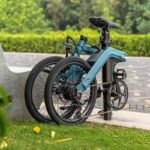How to Know If an Electric Gravel Bike Is Right for You?

Although you have been thinking about an electric gravel bike, you are unsure if it would be the appropriate match for you.
In only ten seconds, this page will assist you in uncovering the solution!
Among bikers, e-dirt bikes are fast becoming to be their first option. They provide effective electric support and let one easily negotiate gravel roads, therefore smoothing out rides and reducing their taxing nature. They might not, however, be for everyone. Are they appropriate for you? Let us ascertain!
Table of Contents
ToggleQuick Test
To find out if an e-gravel bike is the best fit for you, respond to these five questions using “yes” or “no”:
- Do you like adventure riding but occasionally have difficulty with high hills or endurance?
- Does your riding or commute path call for gravel roads, dirt trails, hills, or uneven ground?
- Are you worried about battery range or tiredness, even if you want to cycle further distances?
- You want an easier ride, but you also want to completely rely on an electric motorbike?
- Are you trying for a bike that strikes everyday practicality, off-road stability, and road speed?
Should most of your responses be “yes,” an electric gravel bike might be the best fit for you. Why Might Your Best Option Be an electric gravel bike?
Why an Electric Gravel Bike Might Be Your Best Choice
Long-Distance Riding Without Fatigue
Although discovering new paths is the delight of long-distance riding, physical endurance may often be a challenge. E-gravel bikes use electric assistance to let you ride farther and cut tiredness. This helps you to prolong your travels free from concern for tiredness.
Handling Hills and Gravel Roads with Ease
Usually ranging from 700*35c to 700*45c, gravel e-bike tire widths are broader than road bike tires but smaller than mountain bike tires. While the more contact area improves traction on gravel, loose dirt, and rough terrain, this breadth offers superior stability and comfort. The better rolling efficiency and general handling made possible by the bigger 700mm wheel diameter help to enhance high-speed riding. 700*40c tires of the Fiido C21 electric dirt bike provide a smooth and steady ride on gravel roads as well as city ones.
Balancing Speed, Comfort, and Multi-Terrain Adaptability
Usually constructed on lightweight aluminium alloy or carbon fibre frames, electric gravel bikes improve durability while lowering weight, therefore facilitating the handling of the bike. Most electric gravel bikes weigh between 15 and 18 kg, much less than electric mountain bikes (which often weigh more than 20 kg), which allows for more flexible transitions between various terrains. Their reinforced tread design also helps riders move between gravel trails and paved highways, therefore guaranteeing comfort and efficiency on a range of surfaces.
Embracing this lightweight design concept, the Fiido C21 electric dirt bike weighs just 17.5 kg, far less than many other e-bike models and is simpler to push or carry as needed. Even on difficult terrain, its aluminium alloy frame guarantees durability without adding excessive weight, therefore improving rider control and manoeuvability.
A Cost-Effective Alternative to Cars and Public Transport
Using an electric dirt bike for transportation can result in big savings. With expenses including gasoline, parking, insurance, taxes, and maintenance, the projected annual savings in the UK against a car range from £4,000 to £7,000.
An yearly London Zone 1-5 travelcard costs around £2,700 for individuals who rely on public transport; single trips go up to £5.60 each ride. Public transport costs over a year can run between £2,500 and £3,500.
An e-gravel bike, on the other hand, only requires £24–£48 year in power expenditures; infrequent maintenance fees run from £100–£200 year. It also provides more freedom; you may skip rush hour delays, use ebike lanes, and bypass city traffic.
Most e-gravel bikes provide a battery range of 60–100 km per charge, therefore saving the need for regular recharging. Longer travels call for fewer charging stops and more flexibility. Strong stopping ability of high-performance hydraulic disc brakes also guarantees safety during urban rides and emergency stops.
Retaining Pedal Power While Benefiting from Assistance
E-gravel motorcycles let you vary power levels depending on your needs, unlike fully electric motorbikes. Riders may alternate between pure manual pedalling, minimum or complete electric aid. This allows you to still enjoy the advantages of the exercise from riding, even with additional help available on more difficult terrain.
Is an Electric Gravel Bike Right for You?
A Fiido electric gravel bike is perfect for you if you enjoy long-distance excursions, wish to ride farther with less effort, regularly come across gravel roads or steep hills, and are thinking about substituting public transportation or your own vehicle for your daily commute. At bike store, you can choose the correct model and obtain professional guidance, therefore simplifying the start of your path towards more intelligent, flexible mobility.
For those seeking a sophisticated riding experience, these bikes provide the optimum mix of fitness, comfort, and efficiency.
A typical gravel bike, road bike, or mountain bike would be more suited, though, if your rides are mostly on level roads and you want a manual riding experience.
An electric dirt bike might be the improvement you need if you’re ready to ride longer, climb simpler, and travel smarter.
FAQ
Q. What is the top speed of an electric gravel bike?
A. Regulated by EU and UK legislation, most electric dirt bikes have a maximum assisted speed of 25km/h (15.5 mph). The engine quits helping after this pace is attained, but you may still pedal to quicken yet more. Certain models could provide faster speeds inside the legal limits.
Q. Can a Clectric gravel bike’s battery support long-distance rides?
A. Usually, depending on battery capacity, motor power, assistance mode, and riding circumstances, electric dirt bikes have a range of 60–100km per charge. Reducing the aid level might help to stretch the range. Long-distance rides require either a model with more battery capacity or carry a backup battery.
Q. How Much Heavier is An Electric Gravel Bike Compared to a Regular Gravel Bike?
A. Electric gravel bikes sometimes weigh 15–18 kg, which is somewhat more than standard gravel bikes (10–12 kg), thanks to their additional engine and battery. But they stay lightweight while still offering enough motor assistance without sacrificing agility as compared to full-suspension electric mountain bikes (20 kg or more).
Q. Can an Electric Gravel Bike Handle Harsh Weather Conditions?
A. Indeed, most electric dirt bikes (e.g., IPX5 or above) have some degree of water resistance, which lets you ride on damp road or in light rain. To minimise damage to the motor and battery, it is advisable to avoid deep water nonetheless. Selecting gravel bikes with hydraulic disc brakes and anti-slip tires can improve safety on moist ground.
Q. Does an Electric Gravel Bike Require Special Maintenance?
A. Electric gravel bikes call for more care for the battery and motor system than standard gravel bikes. It’s advised to routinely check battery life and steer clear of long-term low charge storage of it. Other parts, such as the powertrain, braking system, and tires, call for the same upkeep as a standard bike, including chain cleaning, brake pad replacement, and frequent tire pressure checks.
Published by Azura Everhart
Hey, I am Azura Everhart a digital marketer with more than 5+ years of experience. I specialize in leveraging online platforms and strategies to drive business growth and engagement. View more posts
Recent Post
SAP Testing Automation: Tools & Best Practices

A Guide to 3D Rendering Services Across the UK






